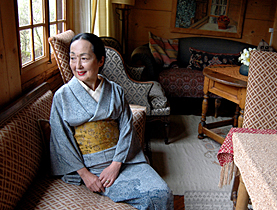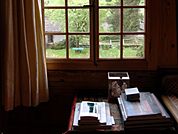A home for aristocratic artists

The Grand Chalet at Rossinière is the biggest chalet in Switzerland and one of the largest wooden dwellings in Europe.
This palatial construction, which became the home of the world famous artist Balthus, can boast of hosting distinguished guests including Victor Hugo, the Dalai Lama and David Bowie.
The train journey from Montreux, on the shore of Lake Geneva, to the tiny alpine village of Rossinière, not far from Gstaad, takes a little under an hour. The view from the panoramic train, as it passes through scenery of breathtaking beauty, is truly magnificent.
It is the first thing you see as Rossinière comes into view: an imposing edifice that dwarfs everything around it looms up in the centre of the village like a vision. It was once described as “a castle covered by a tortoiseshell”.
The Grand Chalet, as it is known, is a veritable gem of traditional Swiss architecture. This colossal dwelling, built by local craftsmen in 1754, was commissioned by Jean David Henchoz, a lawyer and businessman from Rossinière, who came up with the idea in 1750.
Its extraordinary size is due to the plans Henchoz had for it: his ambition was to convert it into a warehouse and regional distribution centre for cheese.
115 windows
The size of the house is breathtaking. The south-facing wall is 27 metres wide by some 19.5 metres high, including a tiled roof measuring 950 square metres.
To build a normal-sized house it takes 30 to 50 cubic metres of wood, the equivalent of 15 to 20 good-quality pine trees. To build the Grand Chalet no fewer than 700 cubic metres of pine were used, which, according to the experts who made the calculation, works out at 200 trees.
The house has a depth of 15 metres and an incredible 115 windows – a daunting prospect for even the most enthusiastic window cleaner! Its current owner admits, with a wry smile, that keeping the chalet spick and span and in a good state of repair poses its challenges.
Another special feature of the house is the façade, decorated with inscriptions and friezes depicting numerous symbolic beasts and flowers. The work took more than 40 days to complete and comprises over 2,800 characters.
The inscriptions reflect the “profound Christian beliefs” of Jean David Henchoz, a businessman and lawyer who, alas, did not live to enjoy his creation. Only two years after the building work was completed – it took four years, from 1752 to 1756 – Henchoz died at the age of 46, having failed to live long enough to see his dream of a cheese emporium become reality.
Balthus’ last dwelling place
The Grand Chalet, which was originally known as the Great House, remained in the Henchoz family until 1875. In 1852 it was converted into a hotel and guest house that was graced by figures of great standing such as Victor Hugo and Alfred Dreyfuss.
Then one day in 1976, another great man, by the name of Balthus, stopped there to take tea. The Franco-Polish artist was instantly bewitched by the house and made up his mind there and then to buy it. And that was when the current phase of its history began.
The chalet gradually became a kind of shrine to Balthus’s work, to which his countless admirers flocked. These included Henri Cartier-Bresson, the legendary photographer, and his wife Martine Franck, Alberto Giacometti, the actor Richard Gere, the singer Bono, the Dalai Lama, and classical musicians such as Riccardo Muti and Zubin Mehta.
One special guest was rock superstar David Bowie, who interviewed Balthus on a couple of occasions for specialist art reviews in Britain: Bowie was not only a friend of Balthus but a connoisseur of his work too.
The samurai countess
When Balthus died, the Grand Chalet passed into the hands of his widow, Countess Setsuko Klossowska de Rola, who graciously agreed to let swissinfo.ch photograph the house and to tell us something of its history.
On our arrival we were greeted by the countess, wearing a traditional kimono, her aura of distinction recalling the grandeur of a bygone age. She escorted us to a drawing room on the ground floor, where she sat and recounted her memories of life in the house.
Setsuko, an artist in her own right and an ambassador for the United Nations cultural organisation Unesco, was born into the Japanese aristocracy and grew up in Tokyo in a traditional samurai family.
She met Balthus in 1962, when he was in Japan on an official visit organised by André Malraux, then Minister of Culture in De Gaulle’s government. They fell in love and married soon after. In 1977 they finally moved into the Grand Chalet at Rossinière.
Museum
Today, what was formerly the cheese store is home to the Balthus Foundation – “although not for much longer”, explains the countess. The plan, she reveals, is “to convert the Grand Chalet into a museum dedicated to the preservation of the memory of Balthus”. It will open to visitors on a permanent basis while continuing to provide a home for her and her daughter.
A particularly important place in the house is Balthus’s studio. Here, in an atmosphere of poignant austerity that recalls a place of worship, are kept the paintings left unfinished by Balthus when he died.
The studio is not open to the public and to be granted access is a rare privilege. It is here that Balthus spent the last night of his life, in February 2001, lying in a simple bed, with his wife Setsuko and his daughter Harumi holding his hands.
“We hardly spoke, but there was something very beautiful about those moments,” recalls the widow of one of the greatest artists of the 20th century.
Rodrigo Carrizo Couto, Rossinière, swissinfo.ch
Construction of this huge building started in 1750, commissioned by local lawyer and businessman Jean David Henchoz.
The work was completed on July 27, 1754.
The Grand Chalet is part of Switzerland’s historic heritage, and as such is a protected monument.
The south façade is 27 meters wide and 19.5 high. The roof measures 950 m2.
More than 700 m3 of pine wood were used for the construction.
The chalet has 115 windows. The decoration on the façades includes religious texts.
Count Balthasar Klossowski de Rola, better known as Balthus, was born in Paris on February 29, 1908 and died at Rossinière on February 18, 2001.
He started to paint professionally in 1924. In 1926 he travelled to Florence to improve his skills. He held his first exhibition in Zurich in 1929, but it was unsuccessful.
His international career started when he gave up surrealism. He painted his first masterpiece. The Street, in 1933.
Between 1961 and 1977 he was the director of the French Academy in the Medici Villa in Rome.
Balthus was nicknamed “king of the cats” because of his fascination with these animals.
In all he painted some 300 pictures. The best known include The Guitar Lesson (1934), La Toilette de Catty (1933), Alice in the Mirror (1933), Teresa sleeping (1938) and La Chambre (1954).
Balthus is famous for his pictures of young women, often half-naked, in ambiguous poses. All of his work is figurative, and plays with the notions of youth and innocence.

In compliance with the JTI standards
More: SWI swissinfo.ch certified by the Journalism Trust Initiative

You can find an overview of ongoing debates with our journalists here. Please join us!
If you want to start a conversation about a topic raised in this article or want to report factual errors, email us at english@swissinfo.ch.